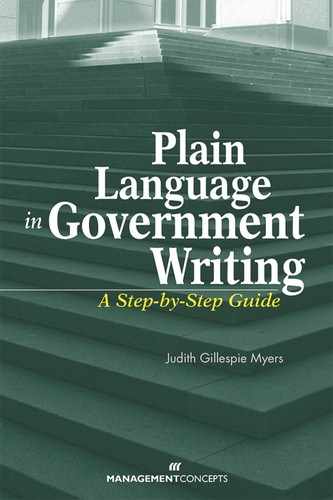![]()
Contents
PART 1 Process and Stages of Plain Language Writing
CHAPTER 1 Succeeding as a Writer in Today’s Workplace
Common Myths about Business Writing
The Importance of Plain Language in Government Writing
Presidential Efforts to Improve Government Writing
Plain Language Helps Avoid Lawsuits
Plain Language Pleases Readers
Plain Language Makes Your Job Easier
CHAPTER 2 Getting Started: The Planning Stage
Guidelines for Brainstorming and Organizing
Turning Generated Ideas into an Outline
Writing an Outline after the Draft
Guidelines for Sequencing Your Ideas
CHAPTER 3 Drafting: Writing It Down
Getting Started on Your First Draft
Qualities of Effective Paragraphs
Getting Some Distance from Your Draft
CHAPTER 4 Editing: Using the Right Voice and Tone
Writing Tip: Prefer the Active Voice
How to Recognize Passive and Active Sentences
The Case for the Passive Voice
How to Activate Passive Sentences
Writing Tip: Bring Submerged Action to the Surface
Writing Tip: Substitute Action Verbs for Forms of “To Be”
Choosing Your Words: Tone in Writing
CHAPTER 5 Editing: Writing with Clarity and Conciseness
Relax Old-Fashioned Grammar Rules
Other Tips for Writing More Clearly
Identify Your Audience Precisely
Avoiding Common Barriers to Understanding
Watch Out for “Noun Sandwiches”
Place Words Carefully within Your Sentences
Use Words Correctly—Especially Similar Words
CHAPTER 6 Adding Visual Impact to Your Writing
Plain Language Guidelines for Visual Formatting
An Example of Plain Language Applied Visually
Enhancing the Text with Graphics
Tables, Line Graphs, Pie Charts, and Bar Charts
CHAPTER 7 editing: the Final Phase
Frequently Used Proofreader’s Marks
Editing Someone Else’s Document
PART II types of Business Writing
CHAPTER 8 emailing the right Message
The Right Recipients and the Right Timing
CHAPTER 9 Writing Winning Letters
How To Format a Business Letter
Common Components of a Business Letter
Basic Steps in Writing Business Letters
Organize the Body of the Letter
Writing to More Than One Audience
Specific Types of Business Letters
IRAC (Issue, Rule, Application, Conclusion) System of Legal Writing
Formatting Your Letters to Increase Effectiveness
Using a Question-and-Answer Format
CHAPTER 10 Creating rousing reports
Basic Parts of an Informal or Brief Report
List of Abbreviations and Symbols
Acknowledgments, Preface, and Foreword
CHAPTER 11 Achieving Skill in technical Writing
The Audience for Technical Writing
Informal or Parenthetical Definitions
Computer- and Web-Based Training
Making Technical Material Accessible
Creating Accessible Graphics and Designs
CHAPTER 12 Other Forms of Workplace Writing
Guidelines for Collaborative Writing
Steps in Preparing for a Briefing or a Presentation
Relate to Your Listeners Personally
Why Written Policies Are Important
